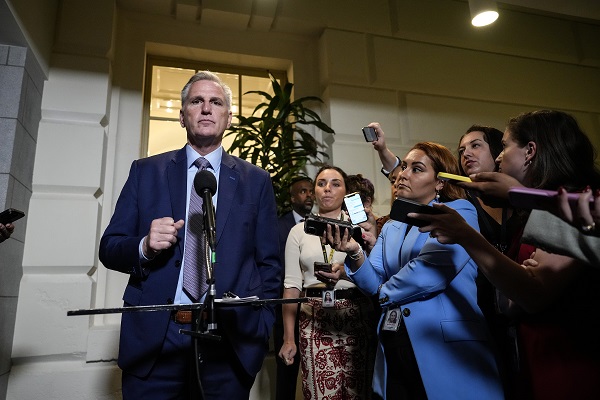online news bulletin news
By Paul M. Krawzak & David Lerman
CQ-Roll Call
(TNS)
Washington (CQ-Roll Call) — House Republicans released a long-delayed budget blueprint Tuesday that promises to bring the federal budget into balance over a decade through steep cuts to discretionary spending, new restrictions on the social safety net and relatively rosy assumptions of consistently strong economic growth. bulletin news
The partisan budget resolution, which the House Budget Committee plans to mark up Wednesday, comes five months after the April 15 deadline set by the 1974 budget law for adoption of the measure, which is designed to guide spending and tax policy.
It stands no chance of winning support in the Democratic-controlled Senate, which is already at loggerheads with House appropriators over fiscal 2024 spending levels. But the document makes good on a political promise by the new House GOP majority to offer a road map to a balanced budget by curbing spending growth.
“Our muscle as Republicans for fiscal responsibility has atrophied over the years, and we’re trying to rebuild that,” House Budget Chairman Jodey C. Arrington told reporters. “And so it’s like going back into the weight room when you haven’t been there in a long time.”
The Texas Republican stopped short of pledging his chamber would adopt the austere fiscal blueprint given the House’s tight GOP margin and little chance for any Democratic support. Arrington said he thinks there are “close to 218” votes for the budget resolution but still not quite enough to adopt it.
“But I can tell you I think the vast majority of our conference supports this,” he said, adding that marking up the budget plan would “encourage at a minimum the debate about what that path forward into a more sustainable fiscal future looks like.”
Details
Arrington’s budget blueprint calls for total fiscal 2024 discretionary spending of $1.47 trillion, the number reflected in House appropriations bills that pares back spending to fiscal 2022 levels. Spending would then be allowed to grow by only 1 percent a year, which amounts to additional cuts after accounting for population growth and inflation.
Certain one-time emergency spending and funding provided under the 2021 infrastructure law would be removed from the “baseline,” or assumptions that Congress will extend current law. Overall, discretionary spending would come down by $4.6 trillion over a decade, according to House Budget GOP staff.
That’s just one piece of a package that would slash projected deficits by $16.3 trillion over a decade, producing a small surplus of $130 billion at the end of 10 years.
online news bulletin news
Mandatory spending that flows independently of annual appropriations, the much larger part of the federal budget, would be cut by $8.7 trillion over a decade, according to the Budget panel.
Of that figure, $1.9 trillion would be saved through Medicaid changes, including imposing work requirements and lowering the federal share of health care services paid to states. Changes to basic cash assistance and food stamp programs, including new work requirements for benefits and restrictions on immigrants, would save $800 billion.
While no Medicare benefit reductions are proposed, the House budget blueprint purports to save $400 billion through several cost-cutting measures aimed at reimbursements to hospitals and other Medicare providers.

And the budget claims $1 trillion in savings by cutting “improper payments” by government agencies in half, though in practice such payments are extremely difficult to claw back.
Additional savings would come by clawing back unspent money from previous laws, such as last year’s Democratic climate, health care and tax package and the 2021 pandemic aid package.
Although Social Security and Medicare are largely untouched in the blueprint, the resolution calls for the creation of a bipartisan commission to recommend changes to the two biggest entitlement programs to ensure their long-term solvency.
House Budget ranking member Brendan F. Boyle, D-Pa., made clear on Tuesday after the GOP plan’s release that his side of the aisle wouldn’t supply votes during Wednesday’s markup.
“MAGA Republicans are driving our nation towards a costly government shutdown because they want to make cruel cuts to everything from health care to education, and this MAGA budget doubles down on their extreme cuts,” Boyle said in a statement.
Aggressive growth projection
The budget also projects economic growth to average about 3 percent a year, producing new revenue of about $3 trillion over the decade that could be applied to deficit reduction. That growth would occur, it says, through policy changes that include deregulation, trade expansion, domestic energy production — and additional tax cuts.
online news bulletin news
If those aggressive growth predictions come true — the Congressional Budget Office’s long-run growth estimate is below 2 percent — it could wipe out costs associated with extending the 2017 tax cuts enacted under President Donald Trump.
The resulting lower deficits would also yield interest savings of about $3 trillion over 10 years.
It’s not clear when GOP leaders will make a decision on putting the budget up for a floor vote, as they scramble to muster enough votes to support a stopgap funding measure by month’s end to avert a partial government shutdown.
Still, adoption of a conservative budget resolution could help appease some hard-line GOP detractors seeking deeper spending cuts who have signaled their opposition to the funding extension unveiled Sunday night.
“It is a shame that our weak Speaker cannot even commit to having a commission to discuss our looming fiscal catastrophe,” Rep. Victoria Spartz, R-Ind., said in a statement declaring her opposition to the stopgap bill. Whether the budget resolution’s call for a commission on entitlements eases that concern is unclear.
Arrington said he hopes the committee’s markup Wednesday will help to persuade dissenters to vote for the stopgap spending measure.
“I hope that this will help grease the skids for us to get a unified Republican funding package on discretionary spending,” he said. Arrington added that it is “absolutely paramount” to include border security measures in the stopgap bill.
Adoption of a budget resolution in the House would be a struggle in the face of what is sure to be united Democratic opposition to spending cuts of that magnitude. The politics could be tricky for House GOP centrists, considering the measure is likely to go nowhere in the Democratic-controlled Senate.
Senate Budget Chairman Sheldon Whitehouse, D-R.I., has no plans to bring up a budget resolution in his committee this year. For one thing, going to the floor would trigger a “vote-a-rama” session of virtually unlimited amendments, putting members of his own party on the spot with politically motivated amendments from Republicans.
©2023 CQ-Roll Call, Inc., All Rights Reserved. Visit cqrollcall.com. Distributed by Tribune Content Agency, LLC.
online news bulletin news


